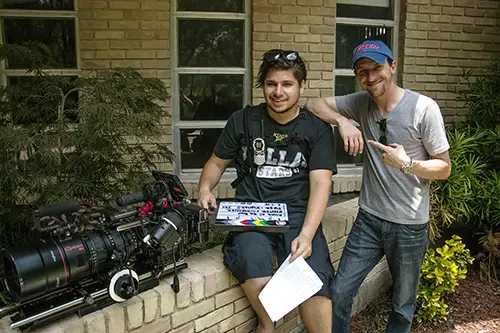Alex Kinter is a Dallas-based director who attended film school in Los Angeles and is a certified master RED Digital Imaging Technician & Director of Photography. In this interview he talks about his passion for film, motion graphics, cinematography, and storytelling.
Film has been your passion for a long time. How did it all start?
It all started in high school during junior year when I had to take a photography class because the video production class was always full and couldn’t ever get in. A buddy of mine in photo class showed me this up and coming fine art and ad photographer in his twenties that had moved out to LA with basically nothing and was stirring things up by crossing over in to obscure video portraits. His name was Tyler Shields. http://www.tylershields.com Then I bought a film camera and a Nikon D70 digital SLR camera and started trying to figure out how light, exposure and depth of field worked by shooting various portraits of my musician friends and when they played live shows.
With the advent of so many online courses, is film school still relevant?
Yes, that’s true for the most part; you can do independent studies and I’m a big believer in that for sure. However, with some technical aspects of the process I’d still recommend best be learned with a hands on approach to make sure those “aha” realization moments occur. I knew quite a bit before going into a program but I think it’s about finding the right type to suit your learning curve preference and sticking to it. There are some programs out there that are a bit sluggish and there are the advanced hands on kind that are more interactive with one on one support as well as team objective based rather than just a classroom setting with homework. I frequently find myself trying to fast track and soak it all in quick.
You’re the Chairman & CEO of Solarity Studios. What is the studio’s mission?
I would say our mission at the studio is to continue making and improving our products and services to our existing and growing clientele. Our feature TV department of Solarity Studios and as well as our film sector, Solarity Motion Pictures, are really starting to expand and take shape with several long format shows and films in development as well as post-production.
Over the year you’ve specialized in post-production. What are some of the more recent project you’ve worked on?
Post-production wise we have recently worked on several music videos, a short film, and couple corporate videos.
How important are motion graphics in today’s film making?
Motion graphics these days are a huge part of post-production. The demand is high for branded content with a cohesive edge to match the rest of companies content.
What are the three most important rules of cinematography?
The three most important rules of cinematography I say would have to be making sure you are tack sharp on what’s important in the shot, try to think of the environment in a 3D space perspective and don’t underestimate the power of fills, negative fills and types diffusion.
What makes visually stimulating and emotionally impactful storytelling?
A carefully crafted visual and musical aesthetic, uniquely lit environment with talent immersed emotionally in the scene, and the unsaid details in the story or character that leave you yearning for more about the world, in which all these elements have come together to dance – makes for visually stimulating and emotionally impactful storytelling.
Now watch Alex Kiter’s reel on his YouTube channel:


